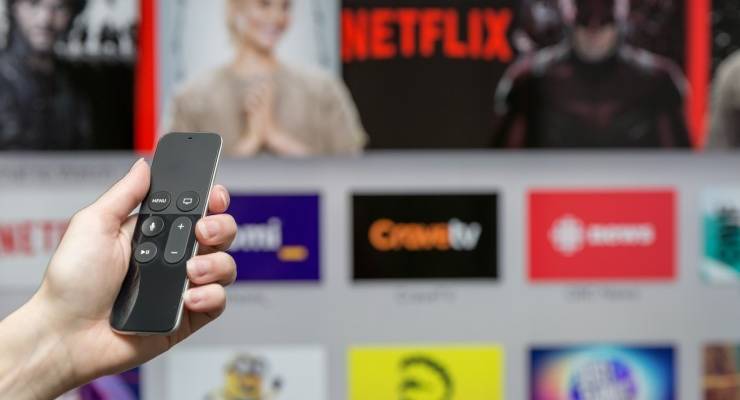
A coalition of global streaming services — Netflix, Disney, Prime, Paramount and local minnow Stan — is lobbying the federal government against content quotas for the Australian screen sector, despite the fact Australia has just 2% local content on those services and that Netflix is delivering 30% local content quotas in European markets.
Last night the streamer coalition put on a panel event in Parliament to sing the virtues of an unfettered screen sector. It dropped some media ahead of it — suggesting Heartbreak High’s runaway success is a case against regulating more Australian content — and produced a report implying the Australian screen sector is in its rudest health since it began making movies in the 1920s.
When referring to the vigour of Australia’s screen sector, the report alludes to the streamers investing $628 million in Australian productions in 2020-21, according to a report by the Australian Communications and Media Authority (ACMA). The actual figure is $178.9 million, a fact the reader can’t check because the report provides a broken link.
The report also fails to address the percentage of Australian shows on streamers, how much of that content is scripted, how algorithms can promote or bury content, and concerning trends — like the fact that in just eight years of streaming, Australian content has almost evaporated.
Instead there are paeans to choice and how stretched the sector is just finding talent. Glossed over is the reality that this talent search often centres on finding Australian riggers and carpenters to support American companies telling American stories on Australian sets.
There’s also a suggestion Australia doesn’t have the capacity to service a growing sector, as though growth of Australian stories and talent was a bad problem to have.
But the subscription-video-on-demand model is not really about choice as the report suggests; the business model is about reducing expenditure on shows, dumping them in overseas markets, and maximising profits.
Do you want more Australian content on your screens? Let us know your thoughts by writing to letters@crikey.com.au. Please include your full name to be considered for publication. We reserve the right to edit for length and clarity.








Streaming services all having a sook about local content quotas here even though it’s good enough for Europe?
Watch them cry “were leaving unless you do what we tell you to do” as the day gets closer
Good riddance and let’s hope the door hits ’em hard on the way out.
The LNP failed to set reasonable quotas for local content when major streaming services began operating in Oz, then reduced the local content quota to minimal levels during Covid.
Fletcher was the minister who continued the long line of LNP ministers who knew our Arts Sector held no votes for the LNP, and couldn’t have cared less about promoting local productions.
It comes down to to – Do we want to hear and see our own stories? Of course we do. Is it healthy for our industry and culture? Of course it is.
I loathe the adoption of USA language here. Even by the ABC and Guardian Australia (‘vultures’ circling cane fires in Burdekin and lambs in ‘diapers’ entering Victorian parliament ).
I remember the former Fairfax press adopting USA spelling and date formats, with the implausibleclaim it would save printing costs.
Does it matter? Yes, through the language the USA culture and values seep in. There is much to admire, but much is antithetical.
Working as a data analyst, the use of USA date formats was a hazard. Is 03/02/2000 03-Feb-2000 or 02-Mar-2000? A company I was working for lost a quarter of data because an operator used a USA date format to identify a data set. Australian governments and most businesses use ddmmyyyy, why does the media sow confusion by insisting on the irrational mmddyyyy?
Some are plain stupid or redundant. ‘Like’ ‘rate ‘hike’, ‘right’ now, ‘anytime’ soon.
My rant. Off to the supermarket for some Anzac Cookies to take to the swim pool. Do the math and go figure buddy, pal. See you at prom guys, a quarter after nine?
We need to step up to the plate and give it a Hail Mary forward pass (try that at the footy!) but do not go to the bathroom on the sidewalk while on the tax payers’ dime etc ad nauseam.walk
Can I take a piss in the restroom?
“Australian governments and most businesses use ddmmyyyy, why does the media sow confusion by insisting on the irrational mmddyyyy?”
As a complete aside, I’m surprised yyyyMMdd isn’t more widely adopted.
That would make too much sense Kel S.
In IT Julian date is widely used (yyyynnn where nnn is the ordinal of the day in that year). It has the benefit of being easy to do calculations involving days.
May also reflect another issue seen offshore, streaming services and content producers (often the same) had a limited supply of content for increasing demand due to Covid, hence, bringing forward production and releases, of much b grade stuff.
Would the streaming services be better with a local quota? Maybe, but then again maybe not. It’s one of those things that sounds good in terms of wanting a local identity, but would we get that? Years ago I remember an analysis of local rules on TV meant that we got more cheap-to-produce reality shows in order to meet the content demands.
I’m sure I’m not alone in wanting quality content. Perhaps quotas might lead to that, or it might lead to Luxe Listings Sydney and The Block to meet that demand. If the latter, then maybe the industry is better off but consumers won’t be.
The sector is aware of that and want sub quotas for scripted shows rather than endless reality pap.